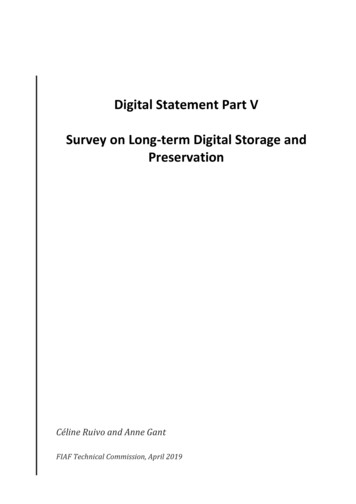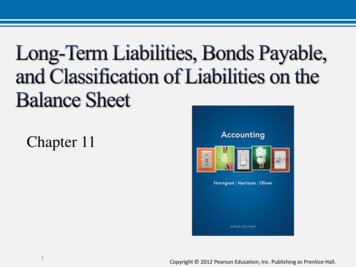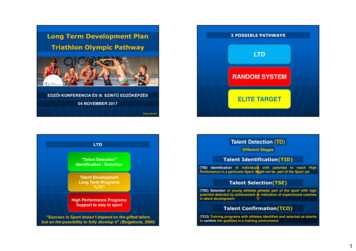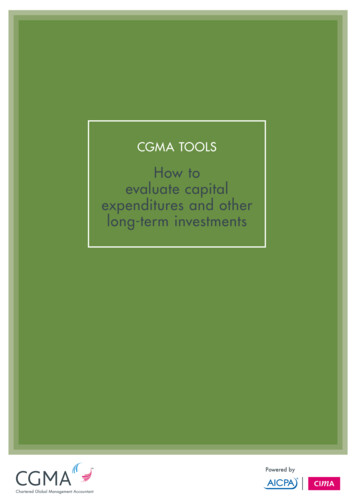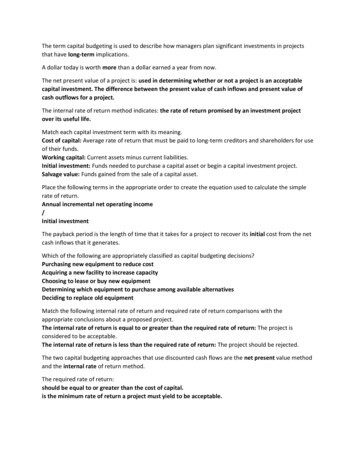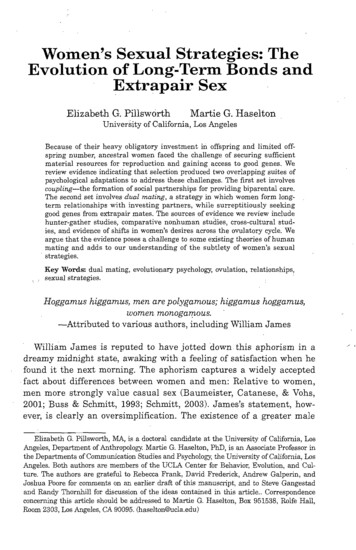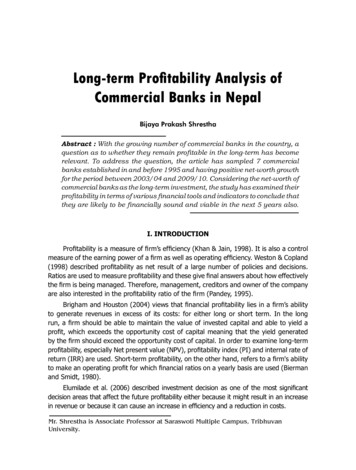
Transcription
Long-term Profitability Analysis ofCommercial Banks in NepalBijaya Prakash ShresthaAbstract : With the growing number of commercial banks in the country, aquestion as to whether they remain profitable in the long-term has becomerelevant. To address the question, the article has sampled 7 commercialbanks established in and before 1995 and having positive net-worth growthfor the period between 2003/04 and 2009/10. Considering the net-worth ofcommercial banks as the long-term investment, the study has examined theirprofitability in terms of various financial tools and indicators to conclude thatthey are likely to be financially sound and viable in the next 5 years also.I. INTRODUCTIONProfitability is a measure of firm’s efficiency (Khan & Jain, 1998). It is also a controlmeasure of the earning power of a firm as well as operating efficiency. Weston & Copland(1998) described profitability as net result of a large number of policies and decisions.Ratios are used to measure profitability and these give final answers about how effectivelythe firm is being managed. Therefore, management, creditors and owner of the companyare also interested in the profitability ratio of the firm (Pandey, 1995).Brigham and Houston (2004) views that financial profitability lies in a firm’s abilityto generate revenues in excess of its costs: for either long or short term. In the longrun, a firm should be able to maintain the value of invested capital and able to yield aprofit, which exceeds the opportunity cost of capital meaning that the yield generatedby the firm should exceed the opportunity cost of capital. In order to examine long-termprofitability, especially Net present value (NPV), profitability index (PI) and internal rate ofreturn (IRR) are used. Short-term profitability, on the other hand, refers to a firm's abilityto make an operating profit for which financial ratios on a yearly basis are used (Biermanand Smidt, 1980).Elumilade et al. (2006) described investment decision as one of the most significantdecision areas that affect the future profitability either because it might result in an increasein revenue or because it can cause an increase in efficiency and a reduction in costs.Mr. Shrestha is Associate Professor at Saraswoti Multiple Campus, TribhuvanUniversity.
68PYC Nepal Journal of Management, August 2011, Vol. IV, No. 1Van Horne (1996) suggested the methods of evaluation of capital budgeting thatare average rate of return (ARR), pay-back period (PBP), internal rate of return (IRR),net present value (NPV), and profitability index (PI). In order to measure long-termprofitability, current study uses especially net present value (NPV), profitability index(PI) and internal rate of return (IRR), the major techniques of capital budgeting. Thecurrent study has used these three techniques on the financial performance of selectedcommercial banks in Nepal, so that the management makes the decision either to acceptor reject the proposal.Pradhan (2007) evaluated the financial ratios, financial distress and stakeholderlosses in corporate restructuring and attempted to explain the behaviour of financialratios in financially distressed firms. But, it did not address any long-term profitabilityposition of the studied firms by using capital budgeting techniques.Etelälahti et al. (1992) described that investments usually refer to the utilizationof long-term benefits through short-term costs. It is highly common that cash-flows areskewed so that the initial cost is high and the benefits are realizing later.Honko et al. (1982) viewed capital investments as a significant outlay of money inorder to receive future benefits. They also highlight that capital investments are importantnot only to the enterprise in question, but to the society as a whole. In addition, thefuture direction and survival of a company is mainly determined by the capability to directits funds towards productive and profitable purposes.If companies do not evaluate projects correctly, and steer the available financialresources to right targets which give out returns more than the cost of capital, it will result todeteriorating value of the corporation (Arnold et al., 2000; Klammer et al., 1991).Poudel, et al. (2010) in their study of capital budgeting of organic coffee productionin Gulmi District of Nepal, used Benefit-Cost ratio (B/C), Net Present Value (NPV), InternalRate of Return (IRR), and Payback Period (PBP) to find out the project’s profitability andeconomic viability.Okechi (2004) presented a profitability assessment tool developed for the purposes ofevaluating the feasibility of fish farming investment and operations. It applied indicators ofinvestment returns such as net present value (NPV) and internal rate of return (IRR), paybackperiod (PBP) and debt service coverage ratio to evaluate the profitability of the venture.Elumilade (2006) used the interest rate as the discount rate for cash-flows. Hence, the currentstudy has adopted the same approach to study the profitability of Nepali commercial banks.Regmi (2005) analysed the profitability of Nepalese commercial banks by analysingthe relationships between EPS, DPS and MPS of the banks. The study, however, did notdeal with the profitability forecasting through capital budgeting techniques.Previous studies related to profitability as well as profit planning and control formanufacturing companies but the number of studies on banks is smaller. Moreover, theydid not apply the capital budgeting techniques as the long-term method for assessingthe profitability of Nepali organisations. The current study is an attempt towards fulfillingthis lacking to some extent.
Long-term Profitability Analysis of Commercial Banks in Nepal 69II. STATEMENT OF THE PROBLEMThe commercial banks in Nepal are a major player in Nepalese banking sectorand financial services industry. With government-owned Nepal Bank Ltd and RastriyaBanijya Bank in operation for several decades, private and foreign joint venture banksalso started operating since 1984 after the establishment of Nepal Arab Bank (NABIL)Ltd. (Sthapit, 2009). Growing competition in the financial sector, recent increase intransaction of security and capital markets as well as the taxation laid on higher depositsin banks are, among others, the factors affecting bank's profitability. The banks' capitalbudgeting decisions vis-a-vis their profitability also come under the influence of the rulesand circulars of Nepal Rastra Bank, the central bank.However, previous studies have not addressed banks’ profitability on a long-termcapital budgeting perspective although it is the area in which researchers, scholars,policy-makers and managers would be interested. Therefore, the study is an attempt toanswer the following research questions: What is the growth rate of net worth of the commercial banks?To what extent have the commercial banks been able to raise their profitability?Are commercial banks in Nepal profitable in future?III. OBJECTIVES OF THE STUDYThe study has the main objective of assessing the profitability of commercial bankson the basis of their cash flows and net worth. The specific objectives to achieve themain objective are: To study growth rate of net-worth of the commercial banksTo analyse profitability of commercial banksTo assess forecasting of profitability of commercial banksIV. RESEARCH METHODOLOGYThe study has used a descriptive and analytical research design. It is based onsecondary data taken from financial statements, annual reports, unpublished officialrecords of concerned banks and web-sites of Nepal Rastra Bank (i.e., www.nrb.org.np)as well as Nepal Stock Exchange (i.e., nepalstock.com).Considering the 24 commercial banks listed at Nepal Stock Exchange (NEPSE) as its totalpopulation, this study initially sampled the eight private commercial banks established in andbefore 1995 as shown in Table 1. However, since the current study related to the long-terminvestment profitability of commercial banks, it has taken the seven banks having a positivegrowth of their net-worth during the study period. Thus, it excluded from the sample set NepalBangladesh Bank Ltd. (NB) for having a negative average net-worth growth as shown with anasterisk mark in Table 1. Hence, the sample banks are Nabil Bank Ltd. (Nabil), Nepal InvestmentBank Ltd. (NIB), Nepal Standard Chartered Bank Ltd. (NSCB), Himalayan Bank Ltd. (HB), NepalSBI Bank Ltd. (NSBI), Everest Bank Ltd. (EB), and Bank of Kathmandu Ltd. (BOK):
teNSBITable 1: Selection of Sample teBOK70PYC Nepal Journal of Management, August 2011, Vol. IV, No. 1
Long-term Profitability Analysis of Commercial Banks in Nepal 71The study covered the period of seven fiscal years from 2003/04 to 2009/10 tostudy the profitability of the investment (measured by net-worth) of commercial banks.Financial tools: To assess the profitability, the study has used the interestrate for measuring the cost of capital of the studied banks, as Sherrick et al. (2000)opined the discounting rate reflects the appropriate cost of capital or rate of returnon the investment (often an interest rate, or cost of capital calculation). Hence, thepredicted cash-flows have been measured by using a discounted rate in the form ofinterest rate.The research has used the net present value (NPV) of their predicted cashflows to assess the profitability of the banks as aimed by the current study. Inprinciple, positive NPV indicates an acceptable bank and negative NPV meansthat the bank-venture is not desirable. For the research purpose, the studyhas forecasted cash-flows of 5 years (i.e., 2010/11 to 2014/15) on the basis ofprevious years’ data.The study has also applied the Profitability Index (PI), the ratio of the present valueof future cash flow over the initial cash outlay of the investment. For a bank-venture tobe acceptable, its benefits must outweigh its costs. In principle, the PI value should bemore than one to make the bank project acceptable.Additionally, the study has also applied the Internal Rate of Return (IRR) toassess and forecast the profitability of the sampled banks, as it is a discountedprofitability and theoretically should be more than the cost of capital to make theventure acceptable. IRR is that discount rate which sets the present value of theproject cash flows equal to the initial investment outlay. The current study has usedthe interest rate as the discount rate for cash-flows, as per the model adopted byElumilade (2006).Statistical tools: The study has used arithmetic mean, growth-rate of the networth, and Weighted rate of interest. To predict the 5-year cash-flows of the banks, thestudy has also run a simple regression on the past data. The data were processed andanalysed on the SPSS and Excel worksheet software.V. LIMITATIONS OF THE STUDYSince only seven banks established in and before 1995 having positive averagegrowth rate in net-worth were selected as a sample, it has excluded more than a dozenof newer banks limiting its study area.Historical data of 7 years (i.e., from 2003/04 to 2009/10) have been collected andanalyzed.Only limited statistical and financial tools, including simple average, net presentvalue (NPV), Profitability index (PI) and internal rate of return (IRR) were used for dataanalysis. Not using more scientific and sophisticated tools may limit the validity of thestudy-findings.
72PYC Nepal Journal of Management, August 2011, Vol. IV, No. 1VI. ANALYSIS OF DATAThe article examines the profitability of seven commercial banks by analysing growthof their past net-worth, essentially the ‘investment’ of each bank venture.4.1 Net-worth of Commercial BanksTable 2 shows that average net-worth of the seven banks ranged from Rs 1,030million (in 2003/04) to Rs 3,214 million (in 2009/10). Their average net-worth figureshave shown an increasing trend.Table 2: Net-worth of Sampled Banks(Rs. in 2144.2 Growth RateThe study also considered growth rates of the net worth calculated by dividing differencebetween subject year net-worth and previous year net-worth by previous year net-worth.The Table 3 shows that the average net-worth growth rate of the seven banksranged from 10.49 percent (HB) to 33.50 percent (NIB). Their total average growth ratefigured 20.16 percent.Table 3: Average Growth Rate of Sampled Banks(Figures in 930.1421.1320.164.3 Discounting Rate of Commercial BanksTh
02.02.2017 · as well as Nepal Stock Exchange (i.e., nepalstock.com). Considering the 24 commercial banks listed at Nepal Stock Exchange (NEPSE) as its total population, this study initially sampled the eight private commercial banks established in and before 1995 as shown in Table 1. However, since the current study related to the long-term investment profitability of commercial banks, it has taken the
